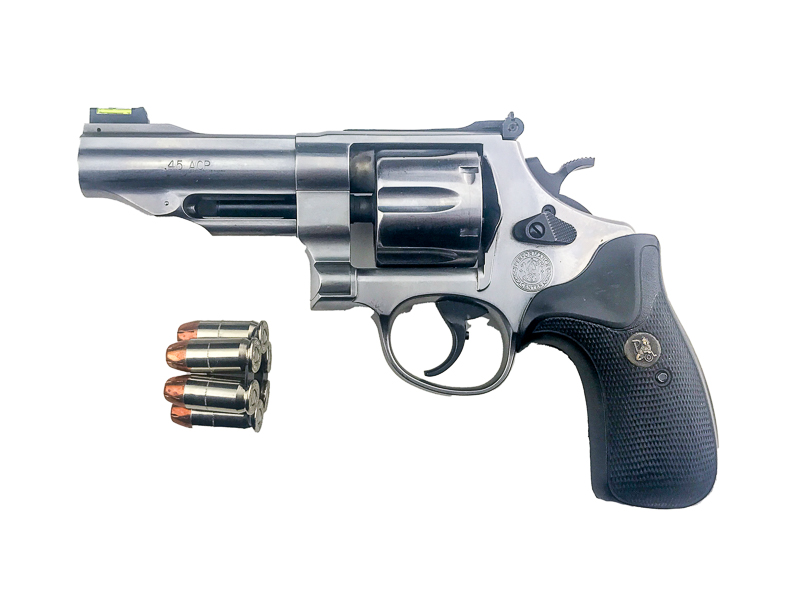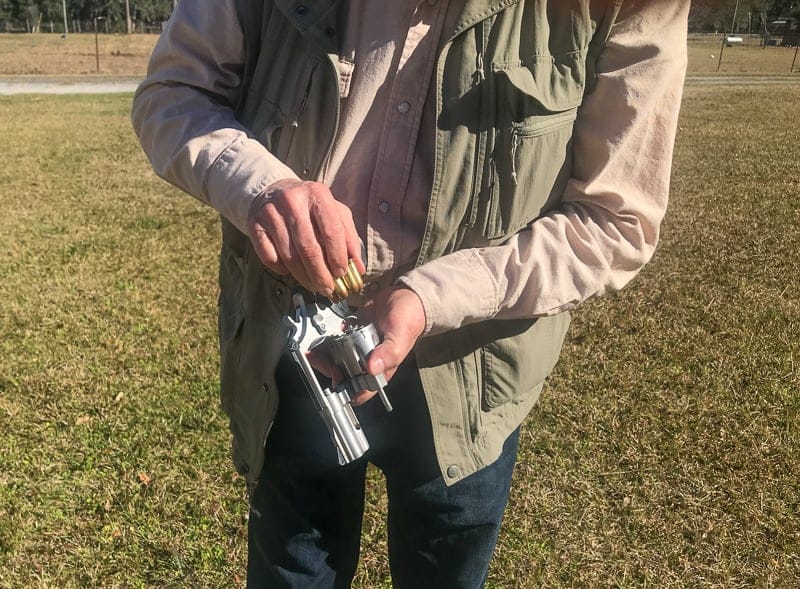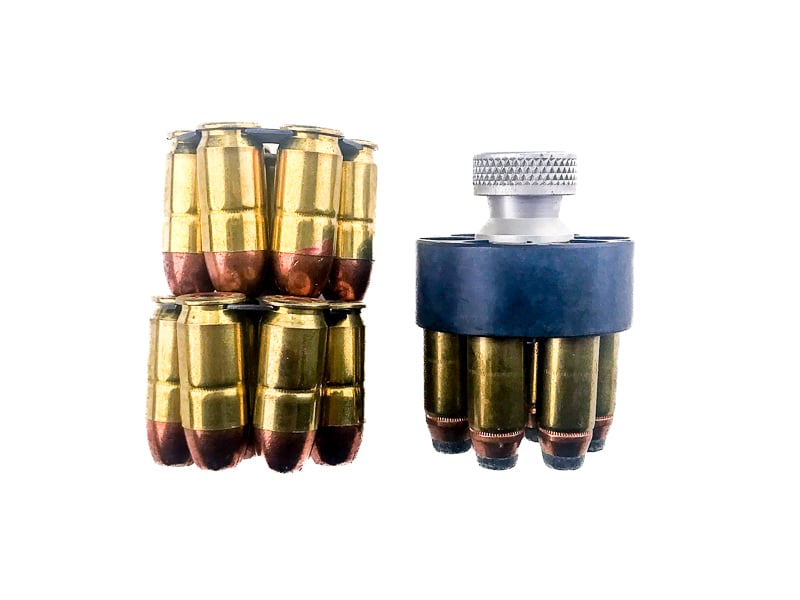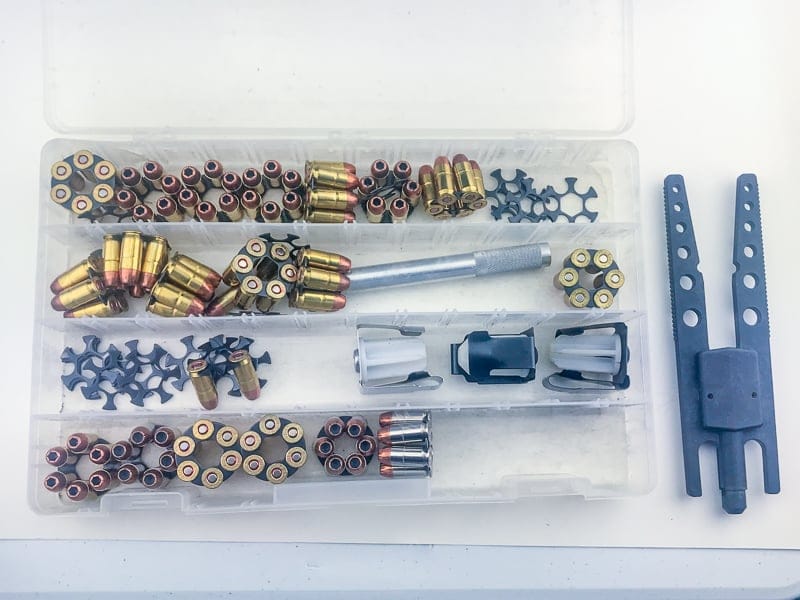Full moon clips are simply the fastest way to load/reload a revolver with a swing-out cylinder. They were developed originally to allow rimless auto pistol cartridges to be loaded into a revolver, though some enthusiasts have the cylinders cut on standard revolver caliber guns to allow the use of the moons with rimmed cartridges such as .38 Special and .357 Magnum.
Conventional wisdom says that three-shot “half-moon” clips were developed in 1916 by Joseph Wesson at Smith & Wesson because America’s entry into WWI was imminent, and there weren’t enough production lines for 1911 pistols to make enough sidearms available for Yanks about to be sent into trench warfare. The large frame Smith & Wesson Hand Ejector and the Colt New Service revolvers were big enough to be chambered for the .45 ACP. These six shooters would each be designated Model 1917. Joseph Wesson’s clips allowed the ejector star to clear out rimless cases and, of course, sped up reloading. It supposedly took American ingenuity until the 1970s to figure out that full moon clips would work even better.
It turns out that conventional wisdom is right about Joseph Wesson and the half-moons of 1916 but wrong about the full moons. In the Volume 55 #1 Spring 2021 issue of the SWCA (Smith & Wesson Collectors Association) Journal, we find an excellent article by researcher and eminent collector Charles Pate titled “David H. Reddie and the Origin of the Model 1917 S&W.” Pate conclusively establishes that “…while Joseph Wesson invented the ‘half-moon’ cartridge clip ultimately used with both the Colt and S&W M1917 revolvers, he first invented the 6-cartridge clip used for the 1916 test and the specification for his October 24, 1915, patent was witnessed by David Hall Reddie.” That patent can be seen in an image from the Journal in the lead photo for this article. Live and learn.

Advantages
Reloading speed is not the only reason we “moonclippers” like the concept, but it’s the most obvious moon clip advantage. No knob to turn, nothing to push; just throw the whole package into the cylinder. Watch the legendary Jerry Miculek fire six rounds from his S&W Model 625, reload, and fire six more in 2.99 seconds. I’ve found the .45 ACP moons give the fastest reloads: with more metal cut away for their fat cartridges, there’s less steel in the cylinder between chambers for the cartridges to get hung up on.

With conventional double-action revolvers, the ejector star can slip over a rim and get caught under the star, a hellacious stoppage to clear. That’s virtually impossible with moon clips. Not only are short auto-caliber cartridge casings likely to clear completely, but they’re all held together.
This same feature makes ejected brass much easier to find and retrieve. Major action shooting matches tend to be “lost brass events.” With other shooters waiting, there’s no time to pick up spent casings one by one, but of course, you’re allowed to retrieve ejected magazines and dropped speedloaders. Happily, your moon clip “speedloader” also contains your brass.

Moon clips are also compact. Two .45 ACP moon clips stacked one above the other occupy about the same space as an N-frame HKS speedloader with .357, .41, or .44 Magnum rounds. Moon clips for shorter 9X19 rounds are even smaller. Moons are also smaller in diameter than same-caliber speedloaders, the bodies of which encompass the cartridges.

Disadvantages
Fragility, bulk, and administrative inconvenience are the big shortcomings with moons. That sheet metal is thin and easy to bend. In WWI, doughboys with 1917s were issued canvas pouches for their half-moon clips. Going prone with such a rig and full moons could put enough body weight against them to bend the clip. That could keep the cylinder from closing or allow it to close, only to find that friction of the bent moon against the frame would prevent the cylinder from turning and freeze the gun. I suspect this was a big reason the US military chose the half-moons.
How to deal with that? When I was first sworn in as a policeman in the early 1970s, my first duty sidearm was a five-screw pre-Model 25 S&W 1955 Target, its barrel cut to four inches and fitted with a Baughman ramp front sight by master gunsmith Nolan Santy. Full moon clips weren’t available then, but a local saddle-maker modified a Leica camera case to fit on my duty belt holding several half-moon clips of .45 ACP. I soon switched to a Colt .45 auto, but a new chief in 1978 insisted that we all carry revolvers, and the 1955 Smith came out of retirement. By now, lightning-fast IPSC shooter John Lazzaro had turned me on to the now-available full moons, with which John could reload his slicked-up 1917 Smith faster than most of us could reload our autos. I found that the Dade N-frame double-speedloader pouch would carry two .45 ACP moons in each rigidly-protected compartment, with its Velcro flaps just barely closing.
You can’t get around the fact that the bulk of a moon clip (or speedloader, for that matter) is about the width of a whole other revolver’s cylinder. Bianchi Speed Strips and Tuff brand Quick Strips are available in .44/.45 size, which allows the use of .45 Auto Rim. Unfortunately, it’s hard to find factory hollow points in the Auto Rim configuration. 9mm moon clip fans are SOL in that respect since Federal has long since discontinued their 9mm Federal round, which was essentially a rimmed version of their excellent 9BP load, a standard velocity 115-grain JHP 9mm round.
If you carry the now-discontinued Taurus five-shot .45 ACP snub or any of the 9mm snubbies to back up a service auto in the same caliber, you can reload from one of your duty gun’s spare magazines by thumbing the cartridges directly from the magazine into the chamber, where they’ll headspace on the case mouth. But you only get one reload, practically speaking. The ejector star will have no rim to catch, and you’ll have to claw out the empties with a thumbnail or punch them out with a D-Jammer or a Bic Stik pen.
I mentioned administrative inconvenience. Moon clips are a pain in the butt to fill and a bigger pain to empty. If you get into this technology you definitely want to invest in “de-mooning” tools available from such sources as Dillon or Brownell’s. You can even get a tool to help you fill the clips.

The full moon clip revolver isn’t for everyone, but it is ideal for some applications. As with anything else, you must take maximum advantage of its strengths and shore up its weaknesses. I have a baker’s dozen in-house and have found them useful for “gun games” and more.


